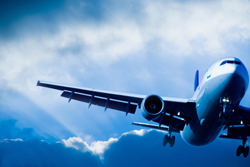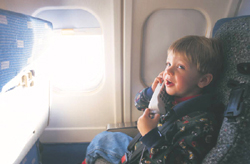- How does air travel affect health?
- Cabin air quality
- Ears and air travel
- Risk of infection
- Motion sickness
- Jet lag
- Deep vein thrombosis
- Who should avoid flying?
- Plane travel during pregnancy
- Tips for healthy plane travel
How does air travel affect health?

Air travel over long distances can expose you to a number of factors that may have an impact on your health and wellbeing. The environmental conditions inside the cabin of an airplane flying at 12,000 metres are vastly different to those on the ground. The plane environment subjects your body to reduced atmospheric pressure, reduced availability of oxygen, relative humidity, noise and vibration. Additionally, there is the risk of acquiring an infection from fellow passengers. Time zone changes can affect performance and enjoyment of your holiday at your destination.
Everyone is affected differently by air travel. People with less than optimal health are at an increased risk of suffering health related problems while travelling on a plane. These may range from minor issues such as dry skin or motion sickness, to more serious ones such as developing a blood clot.
Health risks can be minimised by planning carefully and taking some precautions before, during and after the flight. Some general advice that will help make your in-flight experience more bearable and holiday more enjoyable include:
- Make sure you are as healthy as possible by getting enough rest before leaving.
- An optimal immune system will protect you from catching any colds or other bugs from other passengers.
- Plane food is generally heavily processed and refined, and full of starches and sugar which can make you feel sluggish, so consider taking some healthy snacks such as fruit or nuts.
- Try to avoid alcohol and caffeine, and drink as much water as possible before and during the flight.
Cabin air quality
The humidity in cabin aircraft is usually very low, around 20%, meaning that the air is very dry. Such low humidity can cause dryness of the skin, mouth, nose and other mucous membranes.
Using moisturising lotion on the skin and a saline nasal spray to moisturise the nasal passages can help counteract these effects. For contact lens wearers, using glasses during the flight instead will help prevent the discomfort and irritation of dry eyes.
The cabin air pressure is lower than the air pressure at sea level. The result of this is that less oxygen is taken up by the blood, and gases within the body expand. Healthy passengers adapt reasonably well to these changes, but the very young, the elderly and anyone with a medical condition (e.g. heart or lung disease, anaemia) may not be able to tolerate the lower oxygen level very well. Such passengers can request an additional oxygen supply during the flight.
As the plane takes off, the oxygen in the cabin lowers and your respiratory system adjusts by increasing the rate and volume of breathing. This can make you feel drowsy and you may have difficulty concentrating.
Another consequence of the lower cabin air pressure is swelling or oedema of the legs and feet. Sitting still for extended periods of time leads to the accumulation of excess fluid in the tissue, which may cause the lower limbs to swell. This condition, also known as ‘jet flight leg’, is more common in women over 30 and people with varicose veins. The severity of swelling is related to the cabin temperature and cruising altitude of the aircraft. It tends to become worse the longer the flight and the lower the cabin pressure. Elastic compression stockings applied before the flight can help prevent swelling in those who have recurrent moderate or severe jet flight leg.
Ears and air travel (barotitis media)

Normally as the plane ascends, air escapes from the middle ear, resulting in a popping sensation in the ear. When the plane descends, the air needs to flow back into the middle ear through the Eustachian tube. This action serves to maintain equal pressure on both sides of the ear drum. If it doesn’t happen, the ears and sinuses may feel blocked and painful until the pressure is relieved.
When the Eustachian tube is blocked, the middle ear pressure cannot be equalised, so the air already there is absorbed. This creates a vacuum, sucking the ear drum inward and stretching it. As a result, sound is muffled. If the tube stays blocked, fluid can leak into the area and cause serous otitis. Children have much smaller Eustachian tubes and so are especially vulnerable to blockages.
Swallowing, chewing and yawning can help relieve some of the pain of blocked ears. Swallowing activates the muscle that opens the Eustachian tube, and occurs more often when chewing gum or sucking on mints. These are good to do, especially before take off and during descent. Sleeping during descent should be avoided because it reduces the number of times that you automatically swallow.
If your ears remain blocked, you can try the ‘Valsalva manoeuvre‘. This involves pinching the nose and closing the mouth, while trying to breathe out through the mouth. Care should be taken when performing this technique to avoid using too much force. The pressure created by the cheek and throat muscle should be sufficient.
Ear pain is experienced by about 15% of children during descent. Babies cannot intentionally pop their ears, but popping can be induced by giving them something to suck on, such as a bottle or pacifier (dummy). To prevent discomfort while the plane is descending, do not allow them to sleep. Older children should chew gum, or they can be instructed to perform the Valsalva manoeuvre.
Individuals with a cold or ear, nose or sinus infection should avoid flying because the inability to equalise pressure may result in pain and injury. If travel can’t be avoided, applying decongestant nasal drops just before flight and again before descent may help.
Decongestant pills or nasal sprays can be use an hour before descent to prevent blocked ears. Decongestants help shrink the membrane and help the ears pop more easily. Travellers with allergy problems should take their medication at the beginning of the flight.
Decongestant tablets and sprays should be avoided by people with heart disease, high blood pressure, irregular heart rhythms, thyroid disease or excessive nervousness. Pregnant women should consult a doctor before using decongestants.
If your ears will not unblock even after landing, you can continue to use the techniques suggested above. If your ears still fail to unblock and continue to be painful, consult a doctor, who may have to release the pressure by making a small incision in the ear drum.
Risk of infection
The air inside a plane is changed 20-30 times per hour. The cabin air is carefully controlled and most ventilation systems recirculate 50% of the air after it has passed through filters, which trap particles, bacteria, fungi and viruses.
Infections may be transmitted between passengers who are seated near each other when an infected person sneezes or coughs, or by touch. If you are concerned and are sitting beside someone who is ill, you can ask to move to another available seat. Some other measures that can be taken include carrying antiseptic wipes to clean seat handles, and using an antibacterial hand gel to wash your hands.
Motion sickness

The main symptoms of motion sickness are:
Motion sickness can be reduced by moderating food intake, reclining in your seat and resting your head against the head rest with your eyes closed. This will help reduce stimulation of the visual and vestibular systems.
Preventative medications are available for passengers who are prone to motion sickness. Dimenhydrinate (e.g. Dramamine) and other antihistamines, or hyoscine (e.g. Travacalm) can be prescribed by your doctor.
If you know you suffer from motion sickness, try to get a seat in the midsection of the cabin over the wings, where movement is felt the least. Try to refrain from reading, and open your airvent. You should also avoid drinking alcohol during and 24 hours before the flight.
Jet lag
Jet lag is an inconvenient side effect of travelling that can dampen your holiday experience. The symptoms of jet lag are fatigue, headache and insomnia at your destination.
There are some preventative measures you can take to avoid jet lag, including staying hydrated, adjusting to the local time as quickly as possible, and eating at the local time.
Deep vein thrombosis (DVT)
Cramped seating and confinement to a small space is not only uncomfortable, but it can also put you in a life threatening situation. Prolonged immobility, especially when seated, is a major factor leading to the development of a blood clot in the leg or pelvic vein, commonly referred to as deep vein thrombosis or DVT. The annual incidence of DVT is about 17 cases per 10,000 people.
Extended periods of sitting down causes blood to pool in the legs, potentially leading to the formation of a clot, especially if you have a medical condition which places you at high risk. Occasionally, the clot can break off, travel through the bloodstream and get caught in the lungs. This is known as a pulmonary embolism. It may cause chest pain and shortness of breath, and can be fatal. Blood clots may not show any symptoms but cramping, swelling and discolouration of the calves and feet.
Who should avoid flying?
- Infants less than 2 days old
- Women after the 36th week of pregnancy
- Recent recipients of coronary bypass graft or transluminal coronary angioplasty (unless clearance is given by your doctor)
- Those suffering from:
- Unstable angina pectoris or chest pain
- Recent heart attack or stroke
- Increased intracranial pressure due to trauma, haemorrhage or infection
- Infection of sinuses of ear and nose
- Recent surgery or injury where trapped gases may be present (e.g. abdominal trauma and gastrointestinal surgery, craniofacial and ocular injuries, brain operation and eye operations involving penetration of the eyeball)
- Severe chronic respiratory disease or unresolved pneumothorax
- Sickle cell disease
- Psychotic illness except when fully controlled
- Any active contagious disease
- Frequent or poorly controlled asthmatic attacks
- Decompression sickness after diving
If you have any of these conditions and are planning to fly, you must receive clearance from your general practitioner.
Passengers with mild chronic obstructive pulmonary disease (COPD) who are symptom free can travel safely. However, people with severe COPD must consider using inflight oxygen, as the low oxygen concentration in cabin air can further stress an already compromised oxygen transport system.
Patients with bronchial asthma should carry medication with them.
Plane travel during pregnancy

Most airlines allow pregnant women to travel up until about a month before they are due to give birth, and many ensure that delivery kits and staff with some training in emergency obstetric care are aboard all flights. A number of professional associations and research studies advise that flying is safe until the 36th week of pregnancy with a single foetus, or 32 weeks for twins.
Two research studies have reported adverse pregnancy outcomes in women who travelled frequently by air while pregnant. A study of flight attendants in Finland noted a 30% increase in miscarriage amongst flight attendants who worked during early pregnancy, compared to women who did not fly. A study of women who flew frequently during pregnancy reported that flyers were 1.5 times more likely than non-flyers to give birth prematurely.
While the best available evidence suggests that infrequent air travel during pregnancy is generally safe, you should be aware that:
- Reduced oxygen levels are typical of a pressurised airplane cabin, and pregnant women may be more susceptible to reduced levels of oxygen. Women may be advised by a doctor to organise oxygen tanks while flying, in case they find themselves short of breath.
- Deep vein thrombosis: There is an increased risk of deep vein thrombosis associated with air travel, and also with being pregnant. However, because deep vein thrombosis is a very rare condition, studies examining the incidence of deep vein thrombosis in pregnant women who fly have not been conducted, and it is not possible to say whether or not there is an additional risk of the condition developing in pregnant women who fly.
There are also a number of considerations pregnant women should make before flying, and precautions they should take if they decide to fly. Before flying, all pregnant women should:
- Consult a doctor if in the second half of pregnancy: To assess their general state of health, assess any risk factors which may make air travel dangerous, and obtain any necessary medications (e.g. oxygen) before travelling.
- Ensure adequate medical care is available at the destination: In case of emergency while travelling. This consideration is particularly important for women planning to travel to developing countries, where medical facilities are often inadequate.
- Ensure they have full medical insurance: To cover the costs of any treatment required while travelling, or to cover the costs of tickets which may be cancelled in the event of ill health. This is a key consideration for women planning to travel abroad.
While travelling, pregnant women should make sure that they:
- Move around the cabin at least once an hour to increase blood flow to the legs and reduce the risk of blood clots and thromboembolism. It may be useful to select an aisle seat when checking in, so it is easy to leave the seat and walk around;
- Where support stockings which compress the legs and help make sure blood continues to flow out of the legs, to reduce the risk of thromboembolism.
- Ensure the seatbelt is fastened at all times: Predicting turbulence is difficult. The risk of injury during turbulent events is higher, and may be particularly dangerous for pregnant women.
- Avoid unprescribed medications (e.g. sleeping tablets) unless a doctor has advised that taking such medications is safe.
Tips for healthy air travel
Some preventative measures that may help you beat sickness and leave the plane feeling refreshed are:
- Drink lots of water: This helps keep you hydrated and helps your body function optimally.
- Stretch whenever possible, especially on long flights, to get the blood circulating properly.
- Dress appropriately: The temperature inside the plane can be quite cold.
- Vitamin C: Take a vitamin C tablet daily for a week before you leave, and also during the flight.
- Schedule time to rest as soon as you arrive at your destination.
- Carry medication in your carryon luggage. If you are epileptic or diabetic, or have any other chronic condition, carry a notification and ID card with you.
- Avoid alcoholic and caffeinated drinks.
- Take a decongestant before you get on the plane, especially if you have a cold or swollen sinuses. Also drink plenty of fluids. Remember to swallow often and chew gum.
- To prevent motion sickness, eat a light meal or snack before and during travel.
References
- Chapter 2: Mode of travel: Health considerations. In: International Travel and Health. pp. 12-29[online]. World Health Organization. 19 April 2007 [cited 7 July 2008]. Available from URL: http://whqlibdoc.who.int/ publications/ 2007/ 9789241580397_2_eng.pdf.
- Brundrett G. Comfort and health in commercial aircraft: A literature review. Journal of the Royal Society for the Promotion of Health. 2001; 121(1): 29-37.
- DeHart RL. Health issues of air travel. Annu Rev Public Health. 2003; 24: 133-51.
- Ears and altitude [online]. American academy of Otolaryngology – Head and Neck Surgery. 21 March 2008 [cited 7 July 2008]. Available from URL: http://otolaryngologyheadandnecksurgery.org/ healthinfo/ ears/ altitude.cfm
- Pollard JM, Rice CA [eds]. Health tips for travellers: On the move: Effects of motion, air pressure and time zone changes. Health Hints. June 2008; 12(6): 1-3 [online]. Family and Consumer Sciences: Texas A&M University. June 2008 [cited 7 July 2008]. Available from URL: http://fcs.tamu.edu/ health/ healthhints/ 2008/ jun/ health-tips-for-travelers-part3.pdf
- Stauffer WM, Konop RJ, Kamat D. Traveling with infants and young children Part I: Anticipatory guidance: Travel preparation and preventive health advice. Journal of Travel Medicine. 2000; 8(5): 254-9.
- Lang M. Air travel and children’s health issues. Paediatrics & Child Health. 2007; 12(1): 45-50 [online]. Canadian Paediatric Society. January 2007 [cited 7 July 2008]. Available from URL: http://www.cps.ca/ english/ statements/ CP/ cp07-01.htm
- Chibber R, Al-Sibai MH, Qahtani N. Adverse outcome of pregnancy following air travel: A myth or a concern? Aust NZ J Obstet Gynae. 2006; 46: 24-8.
- Breathnach F, Goeghegan T, Daly S, Turner MJ. Air travel in pregnancy: The air-born study. Irish Med J. 2004; 97(6): 167-8.
- Travel during pregnancy: Patient information leaflet [online]. American College of Obstetricians and Gynaecologists. August 2001 [cited 20 November 2008]. Available from URL: www.acog.org/ publications/ patient_education/ bp055.cfm
- Freeman M, Ghidini A, Spong C, Tchabo N, Bannon P, Pezullo J. Does air travel affect pregnancy outcome? Arch Gynecol. 2004; 269: 274-7.
- Chen J, Lam P. Is it safe to fly during pregnancy? J Chinese Clin Med. 2006; 1(6): 321-6.
- Aspholm R, Lindbohm ML, Paakkulainen H, Taskinen H, Nurminen T, Tiitinen A. Spontaneous abortions among Finnish flight attendants. J Occup Environ Med. 1999; 41(6): 486-91.
- ACOG Committee on Obstetric Practice. Air travel during pregnancy. Int J Gynecol Obstet. 2002; 76(3): 338-9.
- Kingman CE, Economides DL. Travel in pregnancy: Pregnant women’s experiences and knowledge of health issues. J Trav Med. 2003; 10(6): 330-3.
- Clarke MJ, Hopewell S, Juszczak E, Eisinga A, Kjeldstrom M. Compression stockings for preventing deep vein thrombosis in airline passengers. Cochrane Database Syst Rev. 2006; (2): CD004002
All content and media on the HealthEngine Blog is created and published online for informational purposes only. It is not intended to be a substitute for professional medical advice and should not be relied on as health or personal advice. Always seek the guidance of your doctor or other qualified health professional with any questions you may have regarding your health or a medical condition. Never disregard the advice of a medical professional, or delay in seeking it because of something you have read on this Website. If you think you may have a medical emergency, call your doctor, go to the nearest hospital emergency department, or call the emergency services immediately.







